
Illustrative Math Alignment: Grade 7 Unit 9
Putting it All Together
Lesson 10: Measuring Long Distances Over Uneven Terrain
Use the following Media4Math resources with this Illustrative Math lesson.
| Thumbnail Image | Title | Body | Curriculum Topic |
|---|---|---|---|
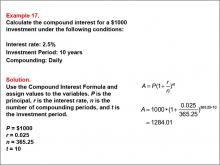
|
Math Example--Math of Money--Compound Interest: Example 17 | Math Example--Math of Money--Compound Interest: Example 17TopicMath of Money DescriptionThis example demonstrates compound interest calculation for a $1000 investment at a 2.5% interest rate over 10 years, compounded daily. Using the formula A = P(1 + r/n)nt, with P = 1000, r = 0.025, n = 365, and t = 10, the result is $1284.01. Understanding compound interest is essential for financial literacy. This example demonstrates daily compounding and its effect on investment growth compared to other frequencies. By exploring various scenarios, students learn how different compounding intervals influence financial outcomes. |
Compound Interest |
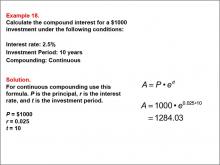
|
Math Example--Math of Money--Compound Interest: Example 18 | Math Example--Math of Money--Compound Interest: Example 18TopicMath of Money DescriptionThis example illustrates compound interest for a $1000 investment at a 2.5% interest rate over 10 years with continuous compounding. The formula for continuous compounding is A = Pert. With P = 1000, r = 0.025, and t = 10, the amount is calculated as $1284.03. Understanding compound interest is crucial for financial literacy. This example demonstrates continuous compounding and its effect on investment growth compared to other frequencies. By exploring various scenarios, students learn how different compounding intervals influence financial outcomes. |
Compound Interest |
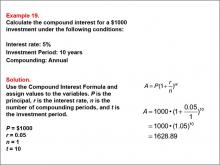
|
Math Example--Math of Money--Compound Interest: Example 19 | Math Example--Math of Money--Compound Interest: Example 19TopicMath of Money DescriptionThis example shows how to calculate compound interest for a $1000 investment with a 5% annual interest rate over 10 years, compounded annually. The formula used is A = P(1 + r/n)nt. Given P = 1000, r = 0.05, n = 1, and t = 10, the calculation yields $1628.89. Understanding compound interest is essential for financial literacy. This example demonstrates annual compounding and its effect on investment growth compared to other frequencies. By exploring various scenarios, students learn how different compounding intervals influence financial outcomes. |
Compound Interest |
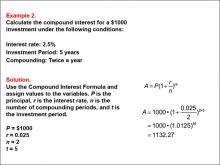
|
Math Example--Math of Money--Compound Interest: Example 2 | Math Example--Math of Money--Compound Interest: Example 2TopicMath of Money DescriptionThis example illustrates the calculation of compound interest for a $1000 investment at a 2.5% interest rate over 5 years, compounded semi-annually. The formula A = P(1 + r/n)nt is applied with P = 1000, r = 0.025, n = 2, and t = 5. The final amount after 5 years is $1132.27. |
Compound Interest |
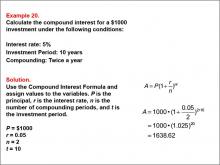
|
Math Example--Math of Money--Compound Interest: Example 20 | Math Example--Math of Money--Compound Interest: Example 20TopicMath of Money DescriptionThis example calculates compound interest for a $1000 investment with a 5% interest rate, compounded twice a year over 10 years. The formula used is A = P(1 + r/n)nt. Given P = 1000, r = 0.05, n = 2, and t = 10, the calculation results in $1638.62. Understanding compound interest is crucial for financial literacy. This example demonstrates semi-annual compounding and its effect on investment growth compared to other frequencies. By exploring various scenarios, students learn how different compounding intervals influence financial outcomes. |
Compound Interest |
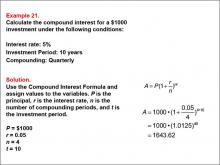
|
Math Example--Math of Money--Compound Interest: Example 21 | Math Example--Math of Money--Compound Interest: Example 21TopicMath of Money DescriptionThis example calculates compound interest for a $1000 investment with a 5% interest rate over 10 years, compounded quarterly. Using the formula A = P(1 + r/n)nt, with P = 1000, r = 0.05, n = 4, and t = 10, the result is $1643.62. Understanding compound interest is essential for financial literacy. This example demonstrates quarterly compounding and its effect on investment growth compared to other frequencies. By exploring various scenarios, students learn how different compounding intervals influence financial outcomes. |
Applications of Exponential and Logarithmic Functions |
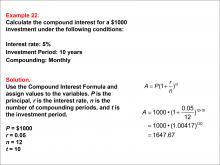
|
Math Example--Math of Money--Compound Interest: Example 22 | Math Example--Math of Money--Compound Interest: Example 22TopicMath of Money DescriptionThis example presents the calculation of compound interest for a $1000 investment with a 5% interest rate over 10 years, compounded monthly. Using the formula A = P(1 + r/n)nt, with P = 1000, r = 0.05, n = 12, and t = 10, the final amount is $1647.67. Understanding compound interest is crucial for financial literacy. This example demonstrates monthly compounding and its effect on investment growth compared to other frequencies. By exploring various scenarios, students learn how different compounding intervals influence financial outcomes. |
Compound Interest |
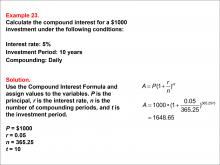
|
Math Example--Math of Money--Compound Interest: Example 23 | Math Example--Math of Money--Compound Interest: Example 23TopicMath of Money DescriptionThis example illustrates calculating compound interest for a $1000 investment with a 5% interest rate over 10 years, compounded daily. Using the formula A = P(1 + r/n)nt, with P = 1000, r = 0.05, n = 365.25, and t = 10, the result is $1648.65. Understanding compound interest is essential for financial literacy. This example demonstrates daily compounding and its effect on investment growth compared to other frequencies. By exploring various scenarios, students learn how different compounding intervals influence financial outcomes. |
Compound Interest |

|
Math Example--Math of Money--Compound Interest: Example 24 | Math Example--Math of Money--Compound Interest: Example 24TopicMath of Money DescriptionThis example shows calculating compound interest for a $1000 investment with a 5% interest rate, compounded continuously over 10 years. The formula used is A = Pert. Given P = 1000, r = 0.05, and t = 10, the calculation results in $1648.72. Understanding compound interest is crucial for financial literacy. This example demonstrates continuous compounding and its effect on investment growth compared to other frequencies. By exploring various scenarios, students learn how different compounding intervals influence financial outcomes. |
Compound Interest |
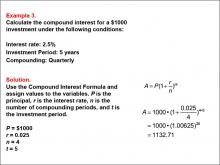
|
Math Example--Math of Money--Compound Interest: Example 3 | Math Example--Math of Money--Compound Interest: Example 3TopicMath of Money DescriptionThis example demonstrates the calculation of compound interest for a $1000 investment at a 2.5% interest rate over 5 years, compounded quarterly. The formula A = P(1 + r/n)nt is used, where P = 1000, r = 0.025, n = 4, and t = 5. The resulting amount after 5 years is $1132.71. |
Compound Interest |
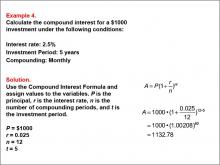
|
Math Example--Math of Money--Compound Interest: Example 4 | Math Example--Math of Money--Compound Interest: Example 4TopicMath of Money DescriptionThis example illustrates the calculation of compound interest for a $1000 investment at a 2.5% interest rate over 5 years, compounded monthly. The formula A = P(1 + r/n)nt is applied with P = 1000, r = 0.025, n = 12, and t = 5. The final amount after 5 years is $1132.78. |
Compound Interest |
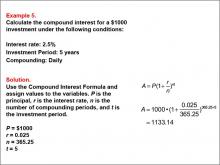
|
Math Example--Math of Money--Compound Interest: Example 5 | Math Example--Math of Money--Compound Interest: Example 5TopicMath of Money DescriptionThis example demonstrates the calculation of compound interest for a $1000 investment at a 2.5% interest rate over 5 years, compounded daily. The formula A = P(1 + r/n)nt is used, where P = 1000, r = 0.025, n = 365.25, and t = 5. The resulting amount after 5 years is $1133.14. |
Compound Interest |

|
Math Example--Math of Money--Compound Interest: Example 6 | Math Example--Math of Money--Compound Interest: Example 6TopicMath of Money DescriptionThis example demonstrates the calculation of compound interest for a $1000 investment at a 2.5% interest rate, compounded continuously over 5 years. Using the formula A = P•ert, where P = 1000, r = 0.025, and t = 5, the final amount is calculated as $1133.15. |
Compound Interest |
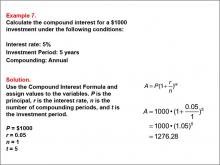
|
Math Example--Math of Money--Compound Interest: Example 7 | Math Example--Math of Money--Compound Interest: Example 7TopicMath of Money DescriptionThis example calculates compound interest for a $1000 investment with a 5% annual interest rate over 5 years, compounded annually. Using the formula A = P(1 + r/n)nt, where P = 1000, r = 0.05, n = 1, and t = 5, the final amount is $1276.28. Compound interest is essential in understanding how investments grow over time. This example emphasizes annual compounding and its effects on investment returns. By examining different compounding frequencies, students can appreciate how often interest is applied impacts overall growth. |
Compound Interest |
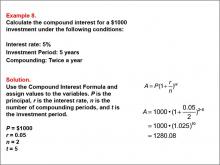
|
Math Example--Math of Money--Compound Interest: Example 8 | Math Example--Math of Money--Compound Interest: Example 8TopicMath of Money DescriptionThis example calculates compound interest for a $1000 investment with a 5% interest rate, compounded semi-annually over 5 years. Using the formula A = P(1 + r/n)nt, where P = 1000, r = 0.05, n = 2, and t = 5, the final amount is $1280.08. Compound interest is fundamental in financial mathematics, illustrating how investments grow over time. This example highlights semi-annual compounding, showing how different frequencies impact returns. Understanding these variations helps students grasp the practical applications of compound interest in real-life scenarios. |
Compound Interest |

|
Math Example--Math of Money--Compound Interest: Example 9 | Math Example--Math of Money--Compound Interest: Example 9TopicMath of Money DescriptionThis example illustrates calculating compound interest for a $1000 investment at a 5% interest rate, compounded quarterly over 5 years. The formula A = P(1 + r/n)nt is used with P = 1000, r = 0.05, n = 4, and t = 5, resulting in an amount of $1282.04. Understanding compound interest is key to financial literacy, showing how investments can grow exponentially. This example demonstrates quarterly compounding and its influence on returns. By examining different compounding intervals, students gain insight into the effects on financial growth. |
Compound Interest |
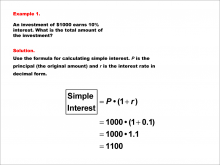
|
Math Example--Math of Money--Simple Interest--Example 1 | Math Example--Math of Money--Simple Interest--Example 1TopicThe Math of Money DescriptionAn investment of $1000 earns 10% interest. Calculate the total amount of the investment after applying simple interest. The solution uses the formula for simple interest: Total Amount = P * (1 + r). Substitute P = 1000 and r = 0.1 to get 1000 * (1 + 0.1) = 1000 * 1.1 = 1100. Thus, the total amount is $1100. Understanding the math of money concepts is crucial for students, as it forms the basis for financial literacy. Examples like this showcase the practical application of simple interest formulas, helping learners to connect theoretical knowledge with real-world scenarios. |
Percents |

|
Math Example--Math of Money--Simple Interest--Example 10 | Math Example--Math of Money--Simple Interest--Example 10TopicThe Math of Money DescriptionAn investment of $50,999 earns 21.55% interest. Calculate the total amount of the investment after applying simple interest. Substitute P = 50999 and r = 0.2155 in the formula Total Amount = P * (1 + r) to get 50999 * (1 + 0.2155) = 50999 * 1.2155 ≈ 61,989.28. Thus, the total amount is approximately $61,989.28. Understanding the math of money concepts is crucial for students, as it forms the basis for financial literacy. Examples like this showcase the practical application of simple interest formulas, helping learners to connect theoretical knowledge with real-world scenarios. |
Percents |
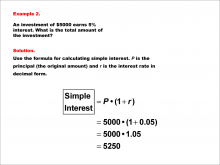
|
Math Example--Math of Money--Simple Interest--Example 2 | Math Example--Math of Money--Simple Interest--Example 2TopicThe Math of Money DescriptionAn investment of $5000 earns 5% interest. Calculate the total amount of the investment after applying simple interest. Using the formula Total Amount = P * (1 + r), substitute P = 5000 and r = 0.05. This gives 5000 * (1 + 0.05) = 5000 * 1.05 = 5250. Therefore, the total amount is $5250. Understanding the math of money concepts is crucial for students, as it forms the basis for financial literacy. Examples like this showcase the practical application of simple interest formulas, helping learners to connect theoretical knowledge with real-world scenarios. |
Percents |
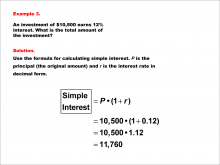
|
Math Example--Math of Money--Simple Interest--Example 3 | Math Example--Math of Money--Simple Interest--Example 3TopicThe Math of Money DescriptionAn investment of $10,500 earns 12% interest. Calculate the total amount of the investment after applying simple interest. Apply the formula Total Amount = P * (1 + r). With P = 10500 and r = 0.12, calculate 10500 * (1 + 0.12) = 10500 * 1.12 = 11760. So, the total amount is $11760. Understanding the math of money concepts is crucial for students, as it forms the basis for financial literacy. Examples like this showcase the practical application of simple interest formulas, helping learners to connect theoretical knowledge with real-world scenarios. |
Percents |
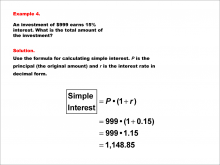
|
Math Example--Math of Money--Simple Interest--Example 4 | Math Example--Math of Money--Simple Interest--Example 4TopicThe Math of Money DescriptionAn investment of $999 earns 15% interest. Calculate the total amount of the investment after applying simple interest. Substitute P = 999 and r = 0.15 into the formula Total Amount = P * (1 + r), resulting in 999 * (1 + 0.15) = 999 * 1.15 = 1148.85. Therefore, the total amount is $1148.85. Understanding the math of money concepts is crucial for students, as it forms the basis for financial literacy. Examples like this showcase the practical application of simple interest formulas, helping learners to connect theoretical knowledge with real-world scenarios. |
Percents |

|
Math Example--Math of Money--Simple Interest--Example 5 | Math Example--Math of Money--Simple Interest--Example 5TopicThe Math of Money DescriptionAn investment of $99.99 earns 7% interest. Calculate the total amount of the investment after applying simple interest. Using the formula Total Amount = P * (1 + r) with P = 99.99 and r = 0.07, compute 99.99 * (1 + 0.07) = 99.99 * 1.07 ≅ 106.99. The total amount is approximately $106.99. Understanding the math of money concepts is crucial for students, as it forms the basis for financial literacy. Examples like this showcase the practical application of simple interest formulas, helping learners to connect theoretical knowledge with real-world scenarios. |
Percents |
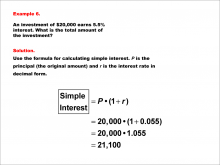
|
Math Example--Math of Money--Simple Interest--Example 6 | Math Example--Math of Money--Simple Interest--Example 6TopicThe Math of Money DescriptionAn investment of $20,000 earns 5.5% interest. Calculate the total amount of the investment after applying simple interest. With P = 20000 and r = 0.055, use the formula Total Amount = P * (1 + r) to get 20000 * (1 + 0.055) = 20000 * 1.055 = 21,100. Therefore, the total amount is $21,100. Understanding the math of money concepts is crucial for students, as it forms the basis for financial literacy. Examples like this showcase the practical application of simple interest formulas, helping learners to connect theoretical knowledge with real-world scenarios. |
Percents |

|
Math Example--Math of Money--Simple Interest--Example 7 | Math Example--Math of Money--Simple Interest--Example 7TopicThe Math of Money DescriptionAn investment of $25,550 earns 10.75% interest. Calculate the total amount of the investment after applying simple interest. Substitute P = 25550 and r = 0.1075 in Total Amount = P * (1 + r). This gives 25550 * (1 + 0.1075) = 25550 * 1.1075 = 26,955.25. So, the total amount is $26,955.25. Understanding the math of money concepts is crucial for students, as it forms the basis for financial literacy. Examples like this showcase the practical application of simple interest formulas, helping learners to connect theoretical knowledge with real-world scenarios. |
Percents |
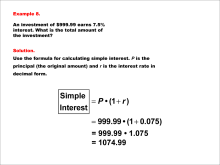
|
Math Example--Math of Money--Simple Interest--Example 8 | Math Example--Math of Money--Simple Interest--Example 8TopicThe Math of Money DescriptionAn investment of $999.99 earns 7.5% interest. Calculate the total amount of the investment after applying simple interest. Using P = 999.99 and r = 0.075 in Total Amount = P * (1 + r), calculate 999.99 * (1 + 0.075) = 999.99 * 1.075 = 1074.99. Thus, the total amount is approximately $1074.99. Understanding the math of money concepts is crucial for students, as it forms the basis for financial literacy. Examples like this showcase the practical application of simple interest formulas, helping learners to connect theoretical knowledge with real-world scenarios. |
Percents |
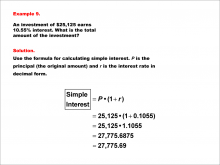
|
Math Example--Math of Money--Simple Interest--Example 9 | Math Example--Math of Money--Simple Interest--Example 9TopicThe Math of Money DescriptionAn investment of $25,125 earns 10.55% interest. Calculate the total amount of the investment after applying simple interest. Using P = 25125 and r = 0.1055 in Total Amount = P * (1 + r), compute 25125 * (1 + 0.1055) = 25125 * 1.1055 ≈ 27,775.69. The total amount is approximately $27,775.69. Understanding the math of money concepts is crucial for students, as it forms the basis for financial literacy. Examples like this showcase the practical application of simple interest formulas, helping learners to connect theoretical knowledge with real-world scenarios. |
Percents |
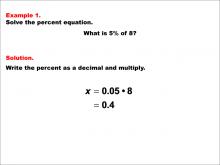
|
Math Example--Percents--Equations with Percents: Example 1 | Math Example--Percents--Equations with Percents: Example 1TopicSolving Equations DescriptionThis math example focuses on solving percent equations, specifically asking "What is 5% of 8?" The solution involves converting 5% to its decimal form, 0.05, and then multiplying it by 8 to get the result of 0.4. This straightforward approach demonstrates how to tackle basic percent calculations efficiently. |
Solving Percent Equations |
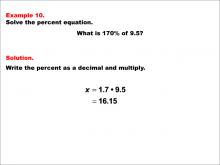
|
Math Example--Percents--Equations with Percents: Example 10 | Math Example--Percents--Equations with Percents: Example 10TopicSolving Equations DescriptionThis math example demonstrates solving percent equations by asking "What is 170% of 9.5?" The solution involves converting 170% to its decimal equivalent, 1.7, and then multiplying it by 9.5 to obtain the result of 16.15. This example combines a percentage greater than 100% with a decimal base number, further illustrating the versatility of the percent-to-decimal conversion method in complex scenarios. |
Solving Percent Equations |
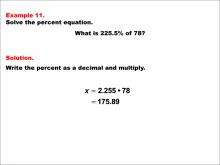
|
Math Example--Percents--Equations with Percents: Example 11 | Math Example--Percents--Equations with Percents: Example 11TopicSolving Equations DescriptionThis math example focuses on solving percent equations, specifically asking "What is 225.5% of 78?" The solution involves converting 225.5% to its decimal form, 2.255, and then multiplying it by 78 to arrive at the answer of 175.89. This example introduces a decimal percentage greater than 200% and a larger whole number as the base value, demonstrating the scalability and flexibility of the percent-to-decimal conversion method in complex scenarios. |
Solving Percent Equations |
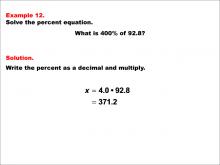
|
Math Example--Percents--Equations with Percents: Example 12 | Math Example--Percents--Equations with Percents: Example 12TopicSolving Equations DescriptionThis math example demonstrates solving percent equations by asking "What is 400% of 92.8?" The solution involves converting 400% to its decimal equivalent, 4.0, and then multiplying it by 92.8 to obtain the result of 371.2. This example showcases how to handle percentages greater than 100% and their application to decimal numbers, illustrating the versatility of the percent-to-decimal conversion method in complex scenarios. |
Solving Percent Equations |
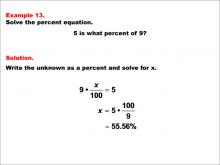
|
Math Example--Percents--Equations with Percents: Example 13 | Math Example--Percents--Equations with Percents: Example 13TopicSolving Equations DescriptionThis math example focuses on solving percent equations by asking "5 is what percent of 9?" The solution involves setting up the equation 9 * (x / 100) = 5, then solving for x to get x = 5 * (100 / 9), which is approximately 55.56%. This example introduces a new type of percent problem where students must find the percentage given two known values. |
Solving Percent Equations |

|
Math Example--Percents--Equations with Percents: Example 14 | Math Example--Percents--Equations with Percents: Example 14TopicSolving Equations DescriptionThis math example demonstrates solving percent equations by asking "6 is what percent of 2.3?" The solution involves setting up the equation 2.3 * (x / 100) = 6, then solving for x to get x = 6 * (100 / 2.3), which is approximately 260.87%. This example introduces a scenario where the resulting percentage is greater than 100% and involves a decimal base number. |
Solving Percent Equations |
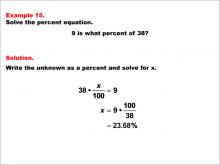
|
Math Example--Percents--Equations with Percents: Example 15 | Math Example--Percents--Equations with Percents: Example 15TopicSolving Equations DescriptionThis math example focuses on solving percent equations by asking "9 is what percent of 38?" The solution involves setting up the equation 38 * (x / 100) = 9, then solving for x to get x = 9 * (100 / 38), which is approximately 23.68%. This example demonstrates how to calculate a percentage when the first number is smaller than the second, resulting in a percentage less than 100%. |
Solving Percent Equations |
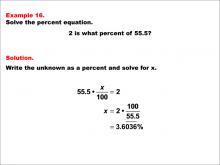
|
Math Example--Percents--Equations with Percents: Example 16 | Math Example--Percents--Equations with Percents: Example 16TopicSolving Equations DescriptionThis math example demonstrates solving percent equations by asking "2 is what percent of 55.5?" The solution involves setting up the equation 55.5 * (x / 100) = 2, then solving for x to get x = 2 * (100 / 55.5), which is approximately 3.6036%. This example introduces a scenario where the resulting percentage is a small fraction, less than 5%, and involves a decimal base number. |
Solving Percent Equations |
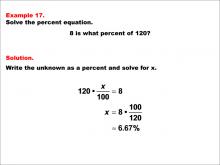
|
Math Example--Percents--Equations with Percents: Example 17 | Math Example--Percents--Equations with Percents: Example 17TopicSolving Equations DescriptionThis math example focuses on solving percent equations by asking "8 is what percent of 120?" The solution involves setting up the equation 120 * (x / 100) = 8, then solving for x to get x = 8 * (100 / 120), which is approximately 6.67%. This example demonstrates how to calculate a percentage when dealing with larger whole numbers, resulting in a percentage less than 10%. |
Solving Percent Equations |

|
Math Example--Percents--Equations with Percents: Example 18 | Math Example--Percents--Equations with Percents: Example 18TopicSolving Equations DescriptionThis math example demonstrates solving percent equations by asking "3.5 is what percent of 350?" The solution involves setting up the equation 350 * (x / 100) = 3.5, then solving for x to get x = 3.5 * (100 / 350), which equals 1%. This example introduces a scenario where the resulting percentage is a whole number (1%) and involves a decimal number as the first value. |
Solving Percent Equations |
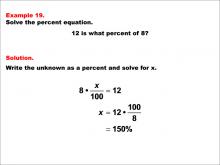
|
Math Example--Percents--Equations with Percents: Example 19 | Math Example--Percents--Equations with Percents: Example 19TopicSolving Equations DescriptionThis math example focuses on solving percent equations by asking "12 is what percent of 8?" The solution involves setting up the equation 8 * (x / 100) = 12, then solving for x to get x = 12 * (100 / 8), which equals 150%. This example demonstrates how to calculate a percentage when the first number is larger than the second, resulting in a percentage greater than 100%. |
Solving Percent Equations |
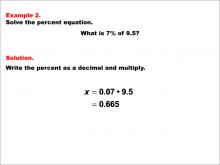
|
Math Example--Percents--Equations with Percents: Example 2 | Math Example--Percents--Equations with Percents: Example 2TopicSolving Equations DescriptionThis math example demonstrates solving percent equations by asking "What is 7% of 9.5?" The solution involves converting 7% to its decimal equivalent, 0.07, and then multiplying it by 9.5 to obtain the result of 0.665. This example builds upon the previous one by introducing a decimal number as the base value. |
Solving Percent Equations |
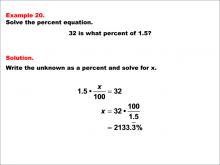
|
Math Example--Percents--Equations with Percents: Example 20 | Math Example--Percents--Equations with Percents: Example 20TopicSolving Equations DescriptionThis math example demonstrates solving percent equations by asking "32 is what percent of 1.5?" The solution involves setting up the equation 1.5 * (x / 100) = 32, then solving for x to get x = 32 * (100 / 1.5), which equals 2133.3%. This example introduces a scenario where the resulting percentage is significantly larger than 100% and involves a decimal base number less than 1. |
Solving Percent Equations |
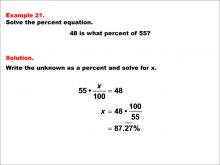
|
Math Example--Percents--Equations with Percents: Example 21 | Math Example--Percents--Equations with Percents: Example 21TopicSolving Equations DescriptionThis math example focuses on solving percent equations by asking "48 is what percent of 55?" The solution involves setting up the equation 55 * (x / 100) = 48, then solving for x to get x = 48 * (100 / 55), which equals 87.27%. This example demonstrates how to calculate a percentage when the two numbers are relatively close in value, resulting in a percentage close to but less than 100%. |
Solving Percent Equations |
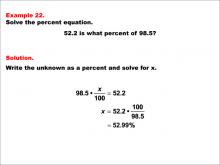
|
Math Example--Percents--Equations with Percents: Example 22 | Math Example--Percents--Equations with Percents: Example 22TopicSolving Equations DescriptionThis math example demonstrates solving percent equations by asking "52.2 is what percent of 98.5?" The solution involves setting up the equation 98.5 * (x / 100) = 52.2, then solving for x to get x = 52.2 * (100 / 98.5), which is approximately 52.99%. This example introduces a scenario where both the numerator and denominator are decimal numbers, resulting in a percentage that is also close to the original numerator. |
Solving Percent Equations |
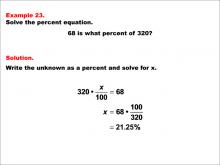
|
Math Example--Percents--Equations with Percents: Example 23 | Math Example--Percents--Equations with Percents: Example 23TopicSolving Equations DescriptionThis math example focuses on solving percent equations by asking "68 is what percent of 320?" The solution involves setting up the equation 320 * (x / 100) = 68, then solving for x to get x = 68 * (100 / 320), which equals 21.25%. This example demonstrates how to calculate a percentage when dealing with whole numbers, resulting in a percentage that's less than 25%. |
Solving Percent Equations |
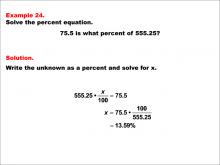
|
Math Example--Percents--Equations with Percents: Example 24 | Math Example--Percents--Equations with Percents: Example 24TopicSolving Equations DescriptionThis math example demonstrates solving percent equations by asking "75.5 is what percent of 555.25?" The solution involves setting up the equation 555.25 * (x / 100) = 75.5, then solving for x to get x = 75.5 * (100 / 555.25), which is approximately 13.59%. This example introduces a scenario where both the numerator and denominator are decimal numbers, resulting in a percentage that's less than 15%. |
Solving Percent Equations |
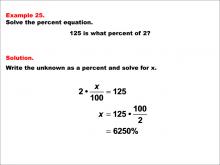
|
Math Example--Percents--Equations with Percents: Example 25 | Math Example--Percents--Equations with Percents: Example 25TopicSolving Equations DescriptionThis math example focuses on solving percent equations by asking "125 is what percent of 2?" The solution involves setting up the equation 2 * (x / 100) = 125, then solving for x to get x = 125 * (100 / 2), which equals 6250%. This example demonstrates how to calculate a percentage when the first number is significantly larger than the second, resulting in a percentage well over 100%. |
Solving Percent Equations |
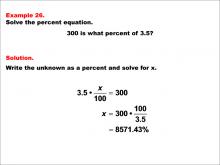
|
Math Example--Percents--Equations with Percents: Example 26 | Math Example--Percents--Equations with Percents: Example 26TopicSolving Equations DescriptionThis math example demonstrates solving percent equations by asking "300 is what percent of 3.5?" The solution involves setting up the equation 3.5 * (x / 100) = 300, then solving for x to get x = 300 * (100 / 3.5), which equals 8571.43%. This example introduces a scenario where the resulting percentage is extremely large, over 8000%, due to the first number being significantly larger than the small decimal base number. |
Solving Percent Equations |
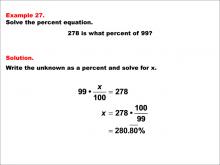
|
Math Example--Percents--Equations with Percents: Example 27 | Math Example--Percents--Equations with Percents: Example 27TopicSolving Equations DescriptionThis math example focuses on solving percent equations by asking "278 is what percent of 99?" The solution involves setting up the equation 99 * (x / 100) = 278, then solving for x to get x = 278 * (100 / 99), which equals 280.80%. This example demonstrates how to calculate a percentage when the first number is significantly larger than the second, resulting in a percentage greater than 200%. |
Solving Percent Equations |
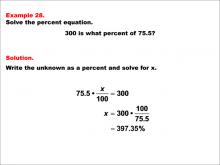
|
Math Example--Percents--Equations with Percents: Example 28 | Math Example--Percents--Equations with Percents: Example 28TopicSolving Equations DescriptionThis math example demonstrates solving percent equations by asking "300 is what percent of 75.5?" The solution involves setting up the equation 75.5 * (x / 100) = 300, then solving for x to get x = 300 * (100 / 75.5), which equals 397.35%. This example introduces a scenario where the resulting percentage is close to 400%, with the first number being significantly larger than the decimal base number. |
Solving Percent Equations |
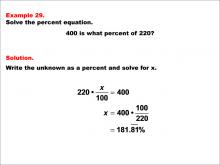
|
Math Example--Percents--Equations with Percents: Example 29 | Math Example--Percents--Equations with Percents: Example 29TopicSolving Equations DescriptionThis math example focuses on solving percent equations by asking "400 is what percent of 220?" The solution involves setting up the equation 220 * (x / 100) = 400, then solving for x to get x = 400 * (100 / 220), which equals 181.81%. This example demonstrates how to calculate a percentage when the first number is nearly double the second, resulting in a percentage between 150% and 200%. |
Solving Percent Equations |

|
Math Example--Percents--Equations with Percents: Example 3 | Math Example--Percents--Equations with Percents: Example 3TopicSolving Equations DescriptionThis math example focuses on solving percent equations, specifically asking "What is 8% of 58?" The solution involves converting 8% to its decimal form, 0.08, and then multiplying it by 58 to arrive at the answer of 4.64. This example introduces a larger whole number as the base value, demonstrating the scalability of the percent-to-decimal conversion method. |
Solving Percent Equations |
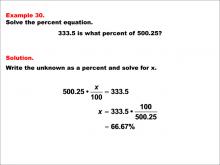
|
Math Example--Percents--Equations with Percents: Example 30 | Math Example--Percents--Equations with Percents: Example 30TopicSolving Equations DescriptionThis math example demonstrates solving percent equations by asking "333.5 is what percent of 500.25?" The solution involves setting up the equation 500.25 * (x / 100) = 333.5, then solving for x to get x = 333.5 * (100 / 500.25), which is approximately 66.67%. This example introduces a scenario where both numbers are decimals and the resulting percentage is less than 100%, showing how to handle more complex decimal calculations. |
Solving Percent Equations |